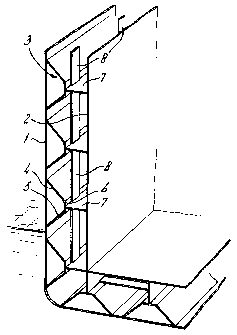Some of the information on this Web page has been provided by external sources. The Government of Canada is not responsible for the accuracy, reliability or currency of the information supplied by external sources. Users wishing to rely upon this information should consult directly with the source of the information. Content provided by external sources is not subject to official languages, privacy and accessibility requirements.
Any discrepancies in the text and image of the Claims and Abstract are due to differing posting times. Text of the Claims and Abstract are posted:
| (12) Patent: | (11) CA 2356848 |
|---|---|
| (54) English Title: | COLLISION-RESISTANT DOUBLE-SKIN STRUCTURE |
| (54) French Title: | STRUCTURE A DOUBLE REVETEMENT RESISTANT AUX CHOCS |
| Status: | Term Expired - Post Grant Beyond Limit |
| (51) International Patent Classification (IPC): |
|
|---|---|
| (72) Inventors : |
|
| (73) Owners : |
|
| (71) Applicants : |
|
| (74) Agent: | MCCARTHY TETRAULT LLP |
| (74) Associate agent: | |
| (45) Issued: | 2008-07-29 |
| (86) PCT Filing Date: | 1999-12-10 |
| (87) Open to Public Inspection: | 2000-06-22 |
| Examination requested: | 2004-11-12 |
| Availability of licence: | N/A |
| Dedicated to the Public: | N/A |
| (25) Language of filing: | English |
| Patent Cooperation Treaty (PCT): | Yes |
|---|---|
| (86) PCT Filing Number: | PCT/NL1999/000757 |
| (87) International Publication Number: | NL1999000757 |
| (85) National Entry: | 2001-06-11 |
| (30) Application Priority Data: | ||||||
|---|---|---|---|---|---|---|
|
An impact-resistant double-skinned structure, such as a
double-skinned ship's side, comprises an outer skin (1) and an
inner skin (2). A series of channels (3) made of a ductile material
and positioned alongside or above one another are attached by
the tips of their side walls (4, 5) to the inner surface of the
outer skin (1) of the structure. The base (6) of each channel is
connected at least by a stringer (7), essentially perpendicular to
said base, to the inner skin (1) of the structure or a construction
attached thereto.
La présente invention concerne une structure à double revêtement résistant aux chocs, comme par exemple la paroi à double revêtement d'un navire, et comprenant un revêtement extérieur (1) et un revêtement intérieur (2). Une série de canaux (3), faits d'une matière ductile et disposés côte à côte ou les uns au-dessus des autres, sont rattachés par les extrémités de leurs parois latérales (4, 5) à la surface intérieure du revêtement extérieur (1) de la structure. La base (6) de chaque canal est reliée au moins par une bande de renforcement (7), essentiellement perpendiculaire à ladite base, au revêtement intérieur (1) de la structure ou à une construction rattachée.
Note: Claims are shown in the official language in which they were submitted.
Note: Descriptions are shown in the official language in which they were submitted.

2024-08-01:As part of the Next Generation Patents (NGP) transition, the Canadian Patents Database (CPD) now contains a more detailed Event History, which replicates the Event Log of our new back-office solution.
Please note that "Inactive:" events refers to events no longer in use in our new back-office solution.
For a clearer understanding of the status of the application/patent presented on this page, the site Disclaimer , as well as the definitions for Patent , Event History , Maintenance Fee and Payment History should be consulted.
| Description | Date |
|---|---|
| Inactive: Expired (new Act pat) | 2019-12-10 |
| Common Representative Appointed | 2019-10-30 |
| Common Representative Appointed | 2019-10-30 |
| Inactive: Late MF processed | 2010-12-29 |
| Letter Sent | 2010-12-10 |
| Grant by Issuance | 2008-07-29 |
| Inactive: Cover page published | 2008-07-28 |
| Pre-grant | 2008-05-13 |
| Inactive: Final fee received | 2008-05-13 |
| Notice of Allowance is Issued | 2007-11-19 |
| Letter Sent | 2007-11-19 |
| Notice of Allowance is Issued | 2007-11-19 |
| Inactive: IPC removed | 2007-10-03 |
| Inactive: Approved for allowance (AFA) | 2007-09-25 |
| Amendment Received - Voluntary Amendment | 2007-07-19 |
| Amendment Received - Voluntary Amendment | 2007-06-19 |
| Amendment Received - Voluntary Amendment | 2007-02-14 |
| Inactive: S.30(2) Rules - Examiner requisition | 2006-08-15 |
| Letter Sent | 2004-11-26 |
| Request for Examination Received | 2004-11-12 |
| Request for Examination Requirements Determined Compliant | 2004-11-12 |
| All Requirements for Examination Determined Compliant | 2004-11-12 |
| Letter Sent | 2001-11-16 |
| Inactive: Cover page published | 2001-10-24 |
| Inactive: Single transfer | 2001-10-09 |
| Inactive: Correspondence - Formalities | 2001-10-09 |
| Inactive: First IPC assigned | 2001-10-02 |
| Inactive: Courtesy letter - Evidence | 2001-09-25 |
| Inactive: Notice - National entry - No RFE | 2001-09-21 |
| Application Received - PCT | 2001-09-20 |
| Application Published (Open to Public Inspection) | 2000-06-22 |
There is no abandonment history.
The last payment was received on 2007-10-15
Note : If the full payment has not been received on or before the date indicated, a further fee may be required which may be one of the following
Patent fees are adjusted on the 1st of January every year. The amounts above are the current amounts if received by December 31 of the current year.
Please refer to the CIPO
Patent Fees
web page to see all current fee amounts.
Note: Records showing the ownership history in alphabetical order.
| Current Owners on Record |
|---|
| SCHELDE MARITIEM B.V. |
| Past Owners on Record |
|---|
| JOHANNES WILHELMUS LUBBERTUS LUDOLPHIJ |